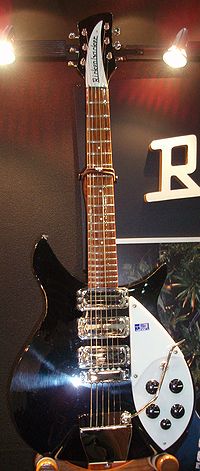Loading AI tools
From Wikipedia, the free encyclopedia
The Rickenbacker 325 is the first of the Capri series of hollow body guitars released in 1958 by Rickenbacker.
This article needs additional citations for verification. (August 2009) |
| Rickenbacker 325 | |
|---|---|
 Rickenbacker 325C64 (A reissue of the 1964 model 325 played by John Lennon) | |
| Manufacturer | Rickenbacker |
| Period | 1958–present |
| Construction | |
| Body type | Semi-hollow |
| Neck joint | Set-in |
| Scale | 20+3⁄4 inches (530 mm) |
| Woods | |
| Body | Maple; alder on 50s instruments & reissues. |
| Neck | Maple; alder on 50s instruments & reissues. |
| Fretboard | Bubinga (1960s–2000s), Paduak (late 1950s), Chechen (current). |
| Hardware | |
| Bridge | 3-way |
| Pickup(s) | Three single-coil pickups |
| Colors available | |
| Mapleglo (natural), Jetglo (black), Fireglo (red sunburst) | |
The 325 was designed by Roger Rossmeisl, a guitar craftsman from a family of German instrument makers. Production models had a 20+3⁄4-inch (530 mm) short scale, dot fretboard inlays, and a small (12+3⁄4-inch-wide [320 mm]) body. The body is unbound, semi-hollow, with an angled sound hole, and boasts "crescent moon"-style cutaways. These instruments gained prominence due to John Lennon's use of a 325 during the early years of The Beatles. Lennon's 1958 model was among the first batch made and has the pre-production feature of a solid top with no sound hole. All subsequent production short-scale 300-series Rickenbackers (310, 315, 320, 325) had sound holes until the late 1970s. This series is currently available only in "C" reissue form, although the reissues lack a sound hole to mimic Lennon's instrument.
Seamless Wikipedia browsing. On steroids.
Every time you click a link to Wikipedia, Wiktionary or Wikiquote in your browser's search results, it will show the modern Wikiwand interface.
Wikiwand extension is a five stars, simple, with minimum permission required to keep your browsing private, safe and transparent.